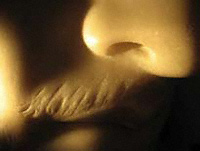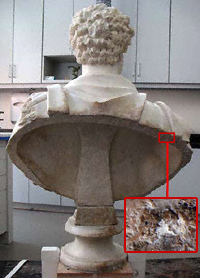 |
Conservators, conservation scientists, curators, and other scholars have studied the Getty Commodus in great detail to determine its origin and date. There is no method available to directly date the sculpted surface of stone. However, scientific examination can provide data that, when interpreted within a framework of comparative findings and historical context, can shed light on the age of a sculpture.
Narrowing down the manufacture date of a marble bust such as the Getty Commodus requires a combination of material analysis, geochemistry, and investigation of carving techniques. |
 |
|
Stone Type
Analyzing minute marble samples from the Getty Commodus, scientists have established that the stone comes from the quarries of Carrara, in Tuscany, Italy. Since this type of marble has been in continuous use from the first century B.C. to the present, this fact can support both an ancient and a modern date for the bust.
Resurfacing
The excellent condition of the Getty Commodus may seem to indicate a post-antique date, but examination of the sculpture's surface has yielded evidence of "resurfacing"—a partial smoothing and recarving. Intended to remove blemishes or burial deposits, this treatment was typical for ancient works restored in the 1700s, when the Commodus was acquired by Lord Carlisle for Castle Howard. Resurfacing removes some of a sculpture's original marble surface—up to two millimeters in the case of the Getty Commodus.
|
 |

Evidence of resurfacing can be seen on the bust's upper lip. Incisions that originally defined strands of the emperor's moustache were smoothed out and then partially rechiseled in an effort to recover lost definition.
|
 |

Resurfacing is also apparent on the bust's drapery, where sections were severely flattened and polished.
|
|
 |
|
Incrustation
Remnants of a pale yellow to brown incrustation with black mineral inclusions were found in several inconspicuous areas of the Getty Commodus, mainly on the circular socle (base) and on the back of the bust. Scientists have determined that this substance consists of calcium carbonate with traces of tephra (volcanic ash), which has been chemically linked to an eruption of Mount Vesuvius.
A likely scenario for this finding is that the sculpture was buried in carbonate-rich soil around the region of Naples for a significant amount of time. Together with the polishing and resculpting of the original surface, this evidence strongly supports the conclusion that the Getty Commodus is ancient, albeit with a significant modern history.
|
 |

Particularly telling is the upper part of the circular socle (base). When the rectangular section above the socle was detached, two distinct surfaces could be observed: a raised, darker, weathered area that had been preserved by the attachment of the bust, surrounded by a lower, lighter, smooth area that, being exposed, had been resurfaced during an earlier restoration.
|
 |

A carbonate crust adheres to the marble surface on the back of the bust.
|
|

|
|
All images on this page: Bust of Commodus, Roman, A.D. 180–185, marble, 27 1/2 in. high. The J. Paul Getty Museum, 92.SA.48
|

|



